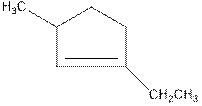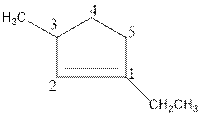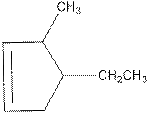
Concept explainers
(a)
Interpretation: The name of the following compound needs to be determined.

Concept Introduction : The name of an organic compound has three parts, prefix, parent chain and suffix. The format of naming is prefix+parent chain+suffix. The parent chain is the longest chain of carbon atoms in the compound. Suffix denote the name of
(a)
Answer to Problem 13E
The name of the compound is but-1-ene.
Explanation of Solution
The structure of the compound is,

The parent chain consists of four carbon atoms. So, the name of parent chain is ‘but’. The compound contains one double bond so, suffix is ‘ene’. So, the name of the compound is but-1-ene.
(b)
Interpretation: The name of the following compound needs to be determined.

Concept Introduction : The name of an organic compound has three parts, prefix, parent chain and suffix. The format of naming is prefix+parent chain+suffix. The parent chain is the longest chain of carbon atoms in the compound. Suffix denote the name of functional group and prefix denote the substituent present in the compound.
(b)
Answer to Problem 13E
The name of the compound is 2-methylbut-2-ene.
Explanation of Solution
The compound is as follows:

In the above compound, four carbon atoms present in the parent chain. So, the name of the parent chain is ‘but’. The compound consists of double bond so, the suffix is ‘ene’. There is one methyl substituent present at C2 so, the name of the compound is 2-methylbut-2-ene.
(c)
Interpretation: The name of the following compound needs to be determined.

Concept Introduction : The name of an organic compound has three parts, prefix, parent chain and suffix. The format of naming is prefix+parent chain+suffix. The parent chain is the longest chain of carbon atoms in the compound. Suffix denote the name of functional group and prefix denote the substituent present in the compound.
(c)
Answer to Problem 13E
The name of the compound is 2, 5-dimethylhept-3-ene.
Explanation of Solution
The compound is as follows:

In the above compound, parent chain consists of seven carbon atoms. So, the name of parent chain is ‘hept’ and there is one double bond at C3 so, suffix is ‘ene’. There are two methyl groups present at C2 and C5 so, the name of the compound is 2,5-dimethylhept-3-ene.
(d)
Interpretation: The name of the following compound needs to be determined.

Concept Introduction: The name of an organic compound has three parts, prefix, parent chain and suffix. The format of naming is prefix+parent chain+suffix. The parent chain is the longest chain of carbon atoms in the compound. Suffix denote the name of functional group and prefix denote the substituent present in the compound.
(d)
Answer to Problem 13E
The name of the compound is 2,3-dimethylpent-1-ene.
Explanation of Solution
The compound is as follows:

In the compound, five carbon atoms present in the parent chain. So, the name of parent chain is ‘pent’ and one double bond present in C1 so, suffix ‘ene’ should be used. Two methyl groups present as substituent in C2 and C3. So, the name of the compound is 2,3-dimethylpent-1-ene.
(e)
Interpretation: The name of the following compound needs to be determined.

Concept Introduction: In naming of cyclic compound, naming is done in the format,
Prefix+Cyclo+parent chain+suffix
Prefix denotes the name of the substituent. If more than one substituent are present, they should be arranged in alphabetical order.
(e)
Answer to Problem 13E
The name of the compound is 1-ethyl-3-methylcyclopent-1-ene.
Explanation of Solution
The compound is as follows:

Above compound is a cyclic compound. The cyclic ring consists of five carbon atoms. So, the name of parent chain is ‘cyclopent’. One double bond is present in C1 so, suffix ‘ene’ should be used. One ethyl substituent is present in C1 and one methyl substituent is present in C3. So, the name of the compound is 1-ethyl-3-methylcyclopent-1-ene.
(f)
Interpretation: The name of the following compound needs to be determined.

Concept Introduction: In naming of cyclic compound, naming is done in the format,
Prefix+Cyclo+parent chain+suffix
Prefix denotes the name of the substituent. If more than one substituent are present, they should be arranged in alphabetical order.
(f)
Answer to Problem 13E
The name of the compound is 4-ethyl-3-methylcyclopent-1-ene.
Explanation of Solution
The compound is as follows:

Above compound is a cyclic compound. The cyclic ring consists of five carbon atoms. So, the name of parent chain is ‘cyclopent’. One double bond is present in C1and C2 so, suffix ‘ene’ should be used. One ethyl substituent is present in C4 and one methyl substituent is present in C3. So, the name of the compound is 4-ethyl-3-methylcyclopent-1-ene.
(g)
Interpretation: The name of the following compound needs to be determined.

Concept Introduction: The name of an organic compound has three parts, prefix, parent chain and suffix. The format of naming is prefix+parent chain+suffix. The parent chain is the longest chain of carbon atoms in the compound. Suffix denotes the name of functional group and prefix denote the substituent present in the compound.
(g)
Answer to Problem 13E
The name of the compound is 4-methylpent-2-yne.
Explanation of Solution
The compound is as follows:

The parent chain of the compound consist of five carbon atoms, so, the name of parent chain is ‘pent’ and one triple bond is present in C2-C3, so, the suffix will be ‘yne’. One methyl substituent is present in C4. So, the name of the compound is 4-methylpent-2-yne.
Want to see more full solutions like this?
Chapter 21 Solutions
Chemical Principles
- CUE COLUMN NOTES (A. Determine Stereoisomers it has ⑤ Identify any meso B compounds cl Br cl -c-c-c-c-¿- 1 CI C- | 2,4-Dichloro-3-bromopentanearrow_forwardThe acid-base chemistry of both EDTA and EBT are important to ensuring that the reactions proceed as desired, thus the pH is controlled using a buffer. What percent of the EBT indicator will be in the desired HIn2- state at pH = 10.5. pKa1 = 6.2 and pKa2 = 11.6 of EBTarrow_forwardWhat does the phrase 'fit for purpose' mean in relation to analytical chemistry? Please provide examples too.arrow_forward
- For each of the substituted benzene molecules below, determine the inductive and resonance effects the substituent will have on the benzene ring, as well as the overall electron-density of the ring compared to unsubstituted benzene. Molecule Inductive Effects Resonance Effects Overall Electron-Density × NO2 ○ donating O donating O withdrawing O withdrawing O electron-rich electron-deficient no inductive effects O no resonance effects O similar to benzene E [ CI O donating withdrawing O no inductive effects Explanation Check ○ donating withdrawing no resonance effects electron-rich electron-deficient O similar to benzene © 2025 McGraw Hill LLC. All Rights Reserved. Terms of Use | Privacy Center Accesarrow_forwardUnderstanding how substituents activate Rank each of the following substituted benzene molecules in order of which will react fastest (1) to slowest (4) by electrophilic aromatic substitution. Explanation HN NH2 Check X (Choose one) (Choose one) (Choose one) (Choose one) © 2025 McGraw Hill LLC. All Rights Reserved. Terms of Use | Privacy Center Aarrow_forwardIdentifying electron-donating and electron-withdrawing effects on benzene For each of the substituted benzene molecules below, determine the inductive and resonance effects the substituent will have on the benzene ring, as well as the overall electron-density of the ring compared to unsubstituted benzene. Inductive Effects Resonance Effects Overall Electron-Density Molecule CF3 O donating O donating O withdrawing O withdrawing O no inductive effects O no resonance effects electron-rich electron-deficient O similar to benzene CH3 O donating O withdrawing O no inductive effects O donating O withdrawing Ono resonance effects O electron-rich O electron-deficient O similar to benzene Explanation Check Х © 2025 McGraw Hill LLC. All Rights Reserved. Terms of Use | Privacy Centerarrow_forward
- * Hint: Think back to Chem 1 solubility rules. Follow Up Questions for Part B 12. What impact do the following disturbances to a system at equilibrium have on k, the rate constant for the forward reaction? Explain. (4 pts) a) Changing the concentration of a reactant or product. (2 pts) b) Changing the temperature of an exothermic reaction. (2 pts) ofarrow_forwardDraw TWO general chemical equation to prepare Symmetrical and non-Symmetrical ethers Draw 1 chemical reaction of an etherarrow_forwardPlease help me with the following questions for chemistry.arrow_forward
 Chemistry for Today: General, Organic, and Bioche...ChemistryISBN:9781305960060Author:Spencer L. Seager, Michael R. Slabaugh, Maren S. HansenPublisher:Cengage Learning
Chemistry for Today: General, Organic, and Bioche...ChemistryISBN:9781305960060Author:Spencer L. Seager, Michael R. Slabaugh, Maren S. HansenPublisher:Cengage Learning Introductory Chemistry: A FoundationChemistryISBN:9781337399425Author:Steven S. Zumdahl, Donald J. DeCostePublisher:Cengage Learning
Introductory Chemistry: A FoundationChemistryISBN:9781337399425Author:Steven S. Zumdahl, Donald J. DeCostePublisher:Cengage Learning- Chemistry: Matter and ChangeChemistryISBN:9780078746376Author:Dinah Zike, Laurel Dingrando, Nicholas Hainen, Cheryl WistromPublisher:Glencoe/McGraw-Hill School Pub Co
 ChemistryChemistryISBN:9781305957404Author:Steven S. Zumdahl, Susan A. Zumdahl, Donald J. DeCostePublisher:Cengage Learning
ChemistryChemistryISBN:9781305957404Author:Steven S. Zumdahl, Susan A. Zumdahl, Donald J. DeCostePublisher:Cengage Learning Chemistry: An Atoms First ApproachChemistryISBN:9781305079243Author:Steven S. Zumdahl, Susan A. ZumdahlPublisher:Cengage Learning
Chemistry: An Atoms First ApproachChemistryISBN:9781305079243Author:Steven S. Zumdahl, Susan A. ZumdahlPublisher:Cengage Learning





